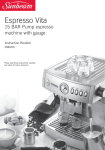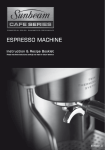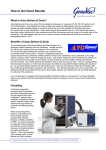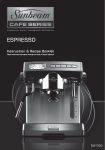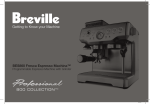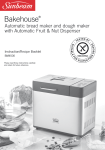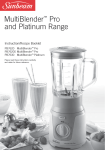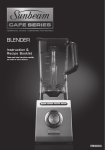Download Danby DDW2405W Instruction manual
Transcript
Dishwashers Instruction Manual Safety Information.............................................1 Dishwasher Features........................................2 Operating Instructions Control Panel......................................................3 Turning On the Appliance .................................4 Dishwasher Accessories...................................4 Wash Cycle Table................................................5 Water Softener....................................................6 Detergent Dispenser...........................................7 Rinse Agent Dispenser.......................................7 Loading the Dishwasher Rack..........................8 Silverware Basket...............................................9 Filtering System.................................................9 Caring for the Dishwasher...........................9,10 Trouble Shooting Tips Before calling for service......................11,12,13 Write the model and serial numbers here: Model # Serial # ver. 1 07.16.04 IMPORTANT SAFETY INFORMATION READ ALL INSTRUCTIONS BEFORE USING WARNING! When using your dishwasher, follow the basic precautions below; WARNING! HYDROGEN GAS IS EXPLOSIVE Under certain conditions, Hydrogen gas may be produced in a hot-water system that has not been used for two weeks or more. HYDROGEN GAS IS EXPLOSIVE. If the hot-water system has not been used for such a period, before using the dishwasher, turn on all hot-water faucets and let the water flow from each for several minutes. This will release any accumulated hydrogen gas. As the gas is flammable, do not smoke or use an open flame during this time. GROUNDING INSTRUCTIONS This appliance must be grounded. In the event of a malfunction or breakdown, grounding will reduce the risk of electric shock by providing a path of the least resistance for an electrical current. This appliance is equipped with a grounding conductor that must be installed in accordance with all local codes and ordinances. WARNING! • Improper connection of the equipment-grounding conductor can result in a risk of electric shock. Check with a qualified electrician or service representative if you are in doubt that the appliance is properly grounded. Safety Precautions • Do not abuse, sit on, or stand on the door or dish rack of the dishwasher. • Do not touch the heating element during or immediately after use. • Do not wash plastic items unless they are marked dishwasher safe or the equivalent. For plastic items not so marked, check the manufacturers recommendations. • Use only detergent and rinse additives designed for an automatic dishwasher. Never use liquid soap, laundry detergent, or hand washing detergent in your dishwasher. • Dishwasher detergents and rinse agents are extremely harmful if swallowed. Keep children away from dishwasher detergent, rinse agent, and the open door of the dishwasher, as there could still be residue of these cleaning agents left inside. • The door should not be left in the open position since this could present a tripping hazard. • During installation, the power supply cable must not be excessively or dangerously bent or flattened. • Do not tamper with controls. • The appliance is not intended for use by young children or infirm persons without supervision. • Do not operate your dishwasher unless all enclosure panels are properly in place. Open the door very carefully if the dishwasher is operating, as there is a risk of water spraying out. • Do no place heavy objects or stand on the door when it is open. The appliance could tip forward. • When loading items to be washed: 1) Load sharp items so that they are not likely to damage the door seal. 2) Load sharp knives with the handles up to reduce the risk of cut-type injuries. • When using your dishwasher, you should prevent plastic items from coming in contact with the heating element. • If any electrical wiring is damaged , it must be replaced by the manufacturer, its service agent or a qualified technician in order to avoid injury. • Please dispose of packing materials properly. • Use the dishwasher only for its intended function. • Remove the door to the washing compartment when removing an old dishwasher from service or discarding it. • Check that the detergent receptacle is empty after completion of the wash cycle. READ AND FOLLOW THIS SAFETY INFORMATION CAREFULLY SAVE THESE INSTRUCTIONS 1 Dishwasher Features Remaining time indication Language Display The length of time the program has left to run will be clearly displayed in the LCD window. This dishwasher offers a unique feature displaying program information in 5 different languages; English, French, Italian, German and Spanish. Overflow protection Adjustable Baskets Your dishwasher has an overfill protection program which will automatically stop the dishwasher from filling and start the drain pump if an overflow condition exists. The upper dish-rack has 2 adjustable positions, the lower dish-rack has collapsible rear tines, both of which offer more (loading) flexibility. Memory Function Salt Warning Indicator The memory function automatically sets the most frequently used program as the current program. Making operation much easier. Lets you know when salt must be added to the salt softener (eliminating guess work) to ensure optimum performance. Rinse Agent Warning Indicator Time delay feature Lets you know when rinse agent must be added to the rinse agent dispenser (eliminating guess work) to ensure optimum performance. This allows you the convenience of programming a delayed start time between 30 mins and 9.5 hrs, so you can avoid using your dishwasher during peak hours. Error Alarm Stainless Steel Tub Fault codes inform the you of abnormal status of the machine. No staining or discoloration of the interior tub. Temperature Display 14 Wash Programs Displays the current program’s default temperature, alternate temperature option and real time wash water temperature. Pressing the “Temperature” button (see Console Panel on pg. 2.) will determine what temperature is displayed. You can choose desired programs according to the soiled level. Such as intensive wash, normal wash, rinse, glass, rapid and pre-wash etc, then you can change the temperature of the wash. Different Wash Temperatures IMPORTANT NOTE: During the last rinse cycle (only) of any selected program the water temperature is controlled by a factory setting that will be higher than the program set temperature, this is not adjustable. Do not be alarmed if you see the temperature during the last rinse cycle exceed the temperature of the set wash program. Depending on the program selected, you can choose optional wash temperature settings. 2 IMPORTANT! To get the best performance from your dishwasher, read all operating instructions before using it for the first time. Control Panel 1 Power Switch: Turn the power supply on/off. 7 Temperature Button: Pressing the temperature button once will reveal the factory set wash temperature for the specified program, pressing the button a second time will enable you to view and select the alternate wash temperature(s) available for that program (see “Wash Temperature Options” below). Pressing this button after a wash cycle has commenced, will display the real-time wash water temperature as it heats up to the selected temperature setting. 2 Language Button: Select from English, Italian, French, German and Spanish languages by pressing the button. 3 Rinse Agent Warning Light: Add more rinse agent as the indicator on the front panel lights up. 4 Display Window: Program remaining time, delay time, running indicator, temperature of water, fault codes, etc. 8 Start / Reset Button: Press this button to start/pause the dishwasher, the light will come on when starting. 5 Program Button: Select different programs 6 according to soiled level, such as; Intensive, Normal and Rinse. Delayed Start Button: Press and hold this button to set the delayed hours for washing. The delayed time is adjusted by 30 minute increments up to 9.5 hours. 9 Salt Warning Light: Add more salt as the indicator on the front panel lights up. 10 Door Handle: Pull it to open the door. The machine will stop automatically when the door is opened. WARNING! It is dangerous to open the door during operation, the water is hot and may scald you. Display Symbols Other Symbols: • Denotes time remaining in wash cycle. • Denotes a delayed start program. Washing Programs: Intensive, Normal, Economic, Rinse, Glass, Rapid and Pre-rinse. • Denotes wash temperature options Digital Display: Displays the remaining time , error code, and the delay start time. Information Display: Program Selection, Error (i.e. Door-Open), etc. Wash Temperature Options: Factory Set / Alternate Normal: 50/ 60oC (122/140oF) Economy: 50/ 60oC (122/140oF) Rinse: 60/ 70oC (140/158oF) Glass: 40/ 50oC (104/122oF) Rapid: 40/ 50oC (104/122oF) Wash Cycle Symbols: 1. Pre-rinse Cycle. 3. Rinse Cycle 2. Main wash Cycle. 4. Drying Cycle The symbols will alternate during the selected program. Pre-Rinse: Intensive: 3 No Temperature Options 50/60/70oC (122/140/158oF) TURNING ON THE APPLIANCE Starting a wash cycle... Changing the Program 1. Pull out the upper and lower dish racks, load the dishes according to the diagrams outlined on page 8 and return the dish racks back to their original position inside the dishwasher. To change from one wash program to another wash program during operation, follow these steps; 1. Turn off the power to the dishwasher, then turn the power back on again. 2. Press the program button to select the desired wash program. 3. Press the start button. NOTE: Water remaining inside the dishwasher from the previous program will automatically be drained when the dishwasher starts. You should check the status of the automatic detergent dispenser to make sure the detergent was not expelled during the previ ous program. Replenish detergent if necessary. 2. Close the door and listen for the door latch to click, signifying the door is locked. If the door is not properly closed, the dishwasher will not operate and the message “DOOR OPEN” will appear in the LCD display once the power is turned on. Open and close the door again, applying a little force if necessary. 3. Press the ON/OFF button. 4. Select the desired wash program (using the program button) and adjust temperature according to the size and soil conditions of the dishes. At the end of the wash 5. Press the Start/Reset button to start the program. 6. After the wash cycle is complete, switch off the machine. Always exercise extreme caution when opening the door and removing dishes immediately after a dishwasher program has just ended (the dishes will be extremely hot and can burn your hands). Leaving the door slightly ajar will allow hot vapors to escape, expediting the cooling down process. The end of a wash program is identified as follows; • The time display will “flash” for 8 seconds. • An audible alarm will sound (during the same 8 second period). NOTE: When the dishwasher program stops at the end of a “delayed start” program (only), the time display will flash, but there is no audible signal. Dishwasher Accessories 3a 1. Upper Rack 3a. Third Tier Spray Nozzle 6. Detergent Dispenser 9. Coarse Filter 2. Spray Arms 4. Water Softener 7. Cup Shelf 10.Rinse Agent Dispenser 3. Lower Rack 5. Main Filter 8. Silverware Basket 11. Inlet Valve 4 12.Junction Box WASH CYCLE TABLE Program Cycle Selection Information Cycle For the heaviest soiled loads, such as pots, pans, casserole dishes and dishes that have been sitting with dried food on them for a while. Intensive For normally soiled loads, such as; pots, plates, glasses and lightly soiled pans. This is the standard daily cycle. Normal For lightly soiled loads, such as; plates, glasses, bowls and lightly soiled pans. Economy Rinse For dishes that need to be rinsed and dried only. Glass A shorter wash for lightly soiled loads. Rapid Description of Cycle Pre-Rinse Pre-Rinse 50oC(122oF) Wash 50/60/70oC (122/140/158oF) Rinse Rinse 65/70/75oC (149/158/167oF) Drying Pre-Rinse #1 Pre-Rinse #2 Wash(50/60oC) (122/140oF) Rinse Rinse(65/70oC) (149/158oF) Drying Pre-Rinse Wash(50/60oC) (122/140oF) Rinse Rinse(65/70oC) (149/158oF) Drying For lightly soiled loads, such as; glasses, crystal and fine china. Rinse Agent 5/20 gr. 5/20 gr. 20 gr. Rinse Rinse(60/70oC) Drying Pre-Rinse Wash(40/50oC) (104/122oF) 15 gr. Rinse Rinse(60/70oC) (140/158oF) Drying Pre-Rinse Wash(40/50oC) (104/122oF) 15 gr. Rinse Rinse(55/60oC) (131/140oF) Pre-wash of dishes, pots and pans while waiting for the load to be completed after subsequent meal. Pre-rinse Detergent pre/main Pre-Rinse ERROR CODES Codes Meanings E1 E2 Low inlet water pressure. Excessive draining time. E3 Water temperature increasing too slow, not reaching required temperature. E4 E6 E7 Over filled. Failure of Temperature Sensor Failure of Temperature Sensor Possible Causes Line faucet is not opened The installation position of the drain pipe is too high. Malfunction of temperature sensor or of heating element. Too much inlet water. Short circuit or break of temperature sensor. Open circuit or break of temperature sensor. WARNING: WHEN AN OVERFLOW OCCURS; This dishwasher is designed to detect water overflow conditions. If an overflow condition occurs, the dishwasher will automatically stop operating and display the corresponding “E4” fault code in the LCD window. The overflow container which is monitored by a safety switch has been filled with water and must be manually emptied before normal dishwasher operations can resume. Refer to “Overflow Conditions” on page 13 for instructions on how to correct this. 5 WATER SOFTENER There are two ways to reduce water hardness: one way is using a water softener, the other is using detergent. If hard water is used in the dishwasher, deposits will form on the dishes and utensils. Your dishwasher is equipped with a special softener that uses a salt specifically designed to eliminate lime and minerals from the water and prevent these formations of deposits from occuring in hard water conditions. * The hardness of the water varies from one location to another. Contact your local water board for information on the hardness of your water supply. Loading the Salt into the Softener Always use salt intended for use with dishwashers. The salt container is located beneath the lower rack and should be filled as follows: 1. Remove the lower basket and then unscrew and remove the cap from the salt container. 2. If you are filling the container for the first time, fill 2/3 of its volume with water. 3. Place the end of the funnel (supplied) into the hole and introduce about 2kg of salt. It is normal for a small amount of water to come out of the salt container. 4. Carefully screw the cap back on. Note: 1. The salt container must be refilled when the salt warning light comes on. Afterwards, even though the salt container is full the indicator light may not turn off until the salt fully dissolves. 2. Remove any spillage of crystals from the inside of the dishwasher tub before starting the dishwasher. Adjusting Salt Consumption The dishwasher is designed to allow for adjusting the amount of salt consumed based on the hardness of the water used. This is intended to optimize and customize the level of salt consumption. 1. Unscrew the cap from the salt container. 2. There is a ring on the container with an arrow on it (see figure to the side), if necessary, rotate the ring counter-clockwise from the minus “-” symbol toward the plus “+” symbol, based on the hardness of the water being used. It is recommended that adjustments be made in accordance with the following chart; WATER HARDNESS Selector Position Salt Consumption (gram/cycle) Clarke Degrees dH mmol/l 0-14 14-36 0~10 18~44 0~1.7 1.8~4.4 / 0 20 36-71 45-89 4.5~8.9 MED 40 71 89 8.9 + 60 - Contact your local water board for information on the hardness of your water supply. 6 DETERGENT DISPENSER The dispenser must be refilled before the start of each wash cycle following the instructions provided in the “Wash Cycle Table”. Your dishwasher uses less detergent and rinse agent than conventional dishwashers. Generally, only one tablespoon of detergent is needed for a normal wash load. Items that are heavily soiled, require more detergent. Always add the detergent just before starting the dishwasher, otherwise it could get damp and will not dissolve properly. Amount of Detergent to Use The amount of detergent needed can vary due to the differences in water hardness. To determine the water hardness in your area, contact your local water utility or area water softening company. The harder the water, the more detergent you may need. Remember, you should adjust the amount of detergent you use little by little, until you find the right amount. Removing Hard Water Spots To remove hard water spots, try the following: • Run dishes through a normal wash program. • Remove all metal dish-ware, such as cutlery, pans, etc., from the dishwasher. • Do not add detergent. • Pour two cups of vinegar into a bowl and set the bowl face up on the lower rack of the dishwasher. • Run the dishwasher though a normal wash program. If this doesn’t work, try the same process with a 1/4 cup of citric acid crystals instead of vinegar. To open the detergent cover, press the button and the cover will flip back. WARNING! Dishwasher detergent is corrosive! Take care to keep it out of the reach of children. RINSE AGENT DISPENSER Proper Use of Detergent Use only detergent specifically made for use in automatic dishwashers. Keep your detergent fresh and dry. Don’t put powder detergent into dispenser until you’re ready to wash dishes. • DO NOT use liquid soap in your dishwasher! Filling the Dispenser The rinse agent dispenser holds 3.5 oz of rinse agent. Under normal conditions, this will last approximately one month. Try to keep it full, but do not overfill. • Make sure the dishwasher door is fully open. • Turn the dispenser knob to the left and lift it out. • Add rinse agent until the indicator window looks full. • Clean up any spilled rinse agent with a damp cloth. • Replace the dispenser cap. Rinse Agent Setting The amount of rinse agent released into the final wash can be adjusted. The factory setting is at a midpoint. If there are rings of calcium (hard water) spots on the dishes, try a higher setting. To adjust the Setting Remove the dispenser cap, then turn the adjuster counterclockwise to increase the amount of rinse agent used and clockwise to decrease the amount of rinse agent used. A rinse agent is released during the final cycle to prevent water droplets and streaks from forming on the dishes. A rinse agent also allows water to “sheet” off the dishes easier and improve drying time. 7 LOADING THE DISHWASHER RACKS For best performance of the dishwasher, follow these loading guidelines. Features and appearance of racks and silverware baskets may vary from your model. How to use the Upper Rack The upper rack is designed to hold more delicate and lighter dish-ware, such as; glasses, coffee/tea cups and saucers, as well as plates, small bowls and shallow pans. Position the dishes and cookware so that they cannot be moved by the spray of water. The upper rack has two adjustable positions, it can be adjusted for height by changing the level of wheels that are inserted into the rails. 1 Cups 2 Small serving bowl 3 Large serving bowl 4 Glasses 5 Saucers 6 Dish 7 Plates How to use the Lower Rack We recommend that you place large items on the lower rack, such as; pots, pans, lids, serving dishes and large bowls (as shown below). It is preferable to place large serving dishes and lids on the side of the racks in order to avoid blocking the rotation of the spray arm. NOTE: Pots and bowls should always be face down. Deep pots should be angled to allow water flow out and not pool in the bottom of the pot. The bottom rack features fold down tines, allowing for the loading of larger pots and/or dishes. 1 Oval Platter 2 Dinner Plates 3 Soup Plates 4 Dessert Dishes 5 Silverware basket 8 SILVERWARE BASKET Silverware should be placed in the silverware basket.. Always exercise caution with sharp or pointed objects when loading and/or unloading utensils. Large and long utensils should be placed in a horizontal position on the upper dish-rack. 1 Forks 5 Knife 2 Soup Spoons 6 Serving spoon 3 Dessert Spoons 7 Gravy ladle 4 Teaspoons 8 Serving fork WARNING! Do not let any item extend through bottom. Filtering System For your convenience, we have placed the drain pump and filtering system within easy reach inside the tub. There are three components of the filtering system; the main filter, the coarse filter, and the fine filter. 1 Main filter Food particles trapped by this filter are pulverized by a special jet on the lower spray arm and washed down the drain. 2 Coarse Filter Larger items that could clog the drain, such as pieces of bone or glass, are trapped in the coarse filter. To remove an item caught in this filter, gently squeeze the tabs on the top of this filter and lift it out. 3 Fine Filter This filter holds soil and food residue in the sump area and prevents it from being deposited on the dishes during a cycle. Caring for the Dishwasher To clean the control panel, use a lightly dampened cloth then dry thoroughly. To clean exterior, use a good appliance polish wax. Never use sharp objects, scouring pads or harsh cleaners on any part of the dishwasher. Protect Against Freezing If your dishwasher is left in an unheated place during the winter, ask a service technician to: 1. Cut off electrical power to the dishwasher 2. Turn off the water supply and disconnect the water inlet pipe from the water valve. 3. Drain water from the inlet pipe and water valve. (Use a pan to catch the water.) 4. Reconnect the water inlet pipe to the water valve. 5. Remove the plastic sump cover in the bottom of tub and use a sponge to soak up water in the rubber boot. Cleaning the Spray Arms It is necessary to clean the spray arms regularly for hard water chemicals will clog the arm jets and bearings. To remove the upper spray arm, unscrew the retaining nut that is holding the arm to the rack. To remove the lower spray arm, prevent the arm itself from rotating while the retaining nut is unscrewed and remove the arm. Wash the arms in warm soapy water and use a soft brush to clean the jets. Replace them after they have been rinsed thoroughly. 9 Cleaning the Filters Filter Assembly For the best performance and results, the filter assembly must be cleaned. The filter efficiently removes food particles from the wash water, allowing it (water) to be recirculated during the cycle. For this reason, it is a good idea to remove the larger food particles trapped in the filter after each wash cycle by rinsing the semicircular filter and cup under running water. To remove the filter assembly, pull on the cup handle in the upward direction. The entire filter assembly should be thoroughly cleaned at least once a month. To clean the coarse filter and the fine filter, use a cleaning brush. Then, reassemble the filter parts as shown in the left figure and reinsert the entire assembly in the dishwasher, positioning in its seat and pressing downward. The dishwasher must never be used without the filters. Improper replacement of the filter may reduce the performance level of the appliance and damage dishes and utensils. WARNING! Never run the dishwasher without the filters in place. Cleaning the Door Depending on usage, you should clean the edge around your door at least once a week. To clean the edge around the door, you should use only a soft warm, damp cloth. WARNING! Never use a spray cleaner to clean the door panel for it could damage the door lock and electrical components. Also, to avoid the risk of scratching or spotting the stainless steel surface, do not use any abrasive cleaners or paper towels to clean the outer surface of the dishwasher. How to Keep Your Dishwasher in Shape • After Every Wash After every wash, tleave the door slightly ajar so that moisture and odors are not trapped inside. • No Solvents or Abrasive Cleaning To clean the exterior and rubber parts of the dishwasher, do not use solvents or abrasive cleaning products. Rather, use only a soft cloth and warm soapy water. To remove spots or stains from the surface of the interior, use a cloth dampened with water and a little white vinegar, or a cleaning product made specifically for automatic dishwashers. • When You Go on a Holiday When you go on a holiday, it is recommended that you run a wash cycle with the dishwasher empty. Turn off the water supply and leave the door slightly ajar. This will help the seals last longer and prevent odors from forming within the appliance. • Seals One of the factors that cause odors to form in the dishwasher, is food remains that are trapped in the seals. Periodic cleaning with a damp sponge will prevent this from occurring. 10 Before Calling for Service.. Troubleshooting Tips Review the charts on the following pages which may eliminate the need for a service call. Problem Dishwasher doesn’t run Possible Causes What To Do Fuse blown, or the circuit Replace fuse or reset circuit breaker. Remove breaker tripped. any other appliances sharing the same circuit as the dishwasher. Power supply is not turned on. Make sure the dishwasher is turned on and the door is closed securely. Water Pressure is low Check that the water supply is connected properly and the water is turned on. Overflow The system is designed to detect an overflow. When it does, it shuts off the circulation pump and turns on the drain pump. Some audible sounds are normal Sound from soft food shredding and detergent cup opening. Utensils are not secure in the baskets or something small has dropped into the basket Ensure everything is secured in the dishwasher. Motor hums Dishwasher has not been used regularly. If you do not use it often, remember to set it to fill and pump out every week. This will help keep the seals moist. Improper detergent Use only detergent designed for automatic dishwashers to avoid suds. To remove suds, open the dishwasher door and let the suds evaporate. Add a gallon of cold water to the tub. Close and latch the dishwasher, then start any program, this will initiate a pre-drain cycle. Repeat if necessary. Spilled rinse agent Always wipe up rinse agent spills immediately. Stained tub interior Detergent with colorant was used. Use only detergent that is free of colorant. Dishes not dry Make sure that the rinse agent dispenser is Rinse agent dispenser is filled. empty Noise Suds in the tub Dishes and flatware not clean Improper program Select a program more appropriate for the soiled condition of the dishes. Improper rack loading Make sure that the action of the detergent dispenser and spray arms are not blocked by large dish-ware. 11 Before Calling for Service..(Cont’d) Problem Possible Causes What To Do Spots and filming on glasses and flatware 1. Extremely hard water 2. Low inlet water temperature. 3. Overloading of the dishwasher. 4. Improper loading 5. Old or damp powder detergent. 6. Empty rinse agent dis penser. 7. Incorrect dosage of detergent. To remove spots and filming from glassware: 1.Take out all metal utensils from the dish washer. 2. Do not add detergent 3. Choose the longest cycle 4. Start the dishwasher and allow it to run for about 18 to 22 minutes, then it will be in the main wash. 5. Open the door and pour 2 cups of white vinegar in the bottom of the dishwasher. 6. Open the door after the dishwasher has completed its cycle. If the vinegar did not work: Repeat above steps, using 1/4 cup(60mls)of citric acid instead of vinegar. Cloudiness on glassware Combination of soft water and too much detergent Use less detergent if you have soft water and select the “Glass” Program. Yellow or brown film on inside surfaces Tea or coffee stains Using a solution of 1/2 cup of bleach and 3 cups of warm water, remove the stains by hand. Warning You have to wait 20 minutes after a cycle to let the heating elements cool down, before cleaning the interior; Otherwise, there is a risk of severe burns. Iron deposits in the water You have to contact a water softener can cause an overall film company for a special filter. White film on inside surface Hard water minerals To clean the interior, use a damp sponge with dishwasher detergent while wearing rubber gloves. Never use any other cleaner than dishwasher detergent to avoid the risk risk of foaming or suds. Detergent left in dispenser cups Dishes are blocking detergent cup Reload the dishes properly Steam Normal phenomenon There is some steam coming through the vent by the door latch during drying and water draining. Black or gray marks on Aluminum utensils rubbing against the dishes dishes Water standing in the bottom of the tub This is normal Dishwasher leaks Over filled dispenser or rinse agent spills Dishwasher isn’t level 12 Use a mild abrasive cleaner to eliminate those marks. A small amount of clean water around the outlet on the bottom rear of the tub keeps the water seal lubricated. Be careful not to overfill the rinse agent dispenser. Spilled rinse agent could cause over-sudsing and lead to overflowing. Wipe away any spills with a damp cloth. Make sure the dishwasher is level. OVERFLOW CONDITIONS: The dishwasher is designed to detect/monitor water overflow conditions. The overflow tube is located in the lower section of the inner door liner. This tube must be kept free and clear of obstructions and debris. In the event of an overflow condition, the water level rises above the height of the overflow tube and is directed into the overflow container.(located at the lower right side of the dishwasher) When the water level reaches a predetermined height, the float switch is activated closing power to the water inlet valve and automatically turns on the pump to evacuate the water inside the tub only. The accumulated water inside the float container must be discharged manually before the dishwasher can be re-started. To empty the float container, follow the instructions below. Before you start; • Disconnect the dishwasher from the electrical power supply. • Turn off the water supply using the shut-off valve located next to the dishwasher or main household shut-off valve. • Remove the kick-plate. • Disconnect the flexible (braid) hose from the water inlet valve. • The overflow container is located at the lower right side of the dishwasher underneath the insulation jacket. (See Fig. 1) • Carefully slide out the dishwasher just enough to access the overflow container, approximately 12” (30.4 cm). IMPORTANT: Keep the dishwasher upright at all times. To drain the overflow container; 1. Remove the rubber plug from the bottom of the float container. (See Fig. 2) 2. Allow the water to drain into a cup or container. 3. Replace the rubber plug, making sure it is firmly secured. 4. Re-install the kick-plate. 5. Carefully slide the dishwasher back into the cabinet. The dishwasher is now ready to be restarted. 13 BUILT-IN DISHWASHER LIMITED IN-HOME PRODUCT WARRANTY This quality product is warranted to be free from manufacturer’s defects in material and workmanship, provided that the unit is installed and operated in compliance with the installation and operating conditions intended by the manufacturer. This warranty is available only to the person to whom the unit was originally sold by Danby. or by an authorized distributor of Danby, and is non-transferable. TERMS OF WARRANTY First Two Years Warranty During the first two years (2), from the original date of purchase, any electrical part(s) of this product found to be defective in materials or workmanship will be repaired or replaced, at warrantor’s option, at no charge to the ORIGINAL purchaser. Third Year Limited Warranty During the third year (3), from the original date of purchase any part(s) including the wash motor, drain pump,spray arms (excluding hoses/clamps) and dishracks found to be defective in materials or workmanship will be repaired or replaced, at warrantor’s option, at no charge to the ORIGINAL purchaser. Ten Year During the third through tenth year, from the original date of purchase, any defect in material or work Limited Warranty manship to the stainless steel tub or stainless door liner (resulting in water leakage) will be repaired or Stainless Steel Tub replaced at warrantor’s option. This warranty is limited to the cost of replacement components only. and Door Liner NOTE: The customer shall be responsible for any/all charges incurred as a result of (repair) labour cost and/or transportation (pick- up and delivery) charges associated with the repair and/or replacement of the stainless steel tub and/or stainless steel door liner. Nothing within this warranty shall imply that Danby will be responsible or liable for any damage to any items placed in this appliance, whether due to any defect of the appliance, or its use, whether proper or improper. EXCLUSIONS Save as herein provided, Danby, there are no other warranties, conditions, representations or guarantees, express or implied, made or intended by Danby or its authorized distributors and all other warranties, conditions, representations or guarantees, including any warranties, conditions, representations or guarantees under any Sale of Goods Act or like legislation or statue are hereby expressly excluded. Save as herein provided, Danby, shall not be responsible for any damages to persons or property, including the unit itself, howsoever caused or any consequential damages arising from the malfunction of the unit and by the purchase of the unit, the purchaser does hereby agree to indemnify and save harmless Danby from any claim for damages to persons or property caused by the unit. GENERAL PROVISIONS No warranty or insurance herein contained or set out shall apply when damage or repair is caused by any of the following: 1) Improper Installation 2) Power Failure. 3) Damage in transit or when moving the appliance. 4) Improper power supply such as low voltage, defective house wiring or inadequate fuses. 5) Accident, alteration, abuse or misuse of the appliance such as inadequate air circulation in the room or abnormal operating conditions. 6) Use for commercial or industrial purposes. 7) Fire, water damage, theft, war, riot, hostility, acts of God such as hurricanes, floods etc. 8) Service calls resulting in customer education. Proof of purchase date will be required for warranty claims; so, please retain bills of sale. In the event warranty service is required, present this document to our AUTHORIZED SERVICE AGENT. Danby Products Ltd. Guelph, Ontario, Canada N1H 6Z9 Danby Products Inc. Findlay, Ohio, USA 45839-0669 0















